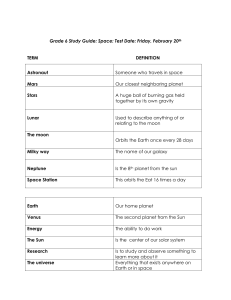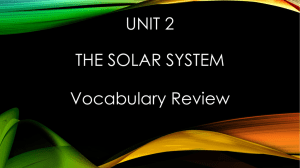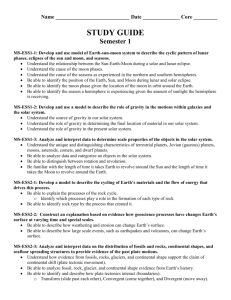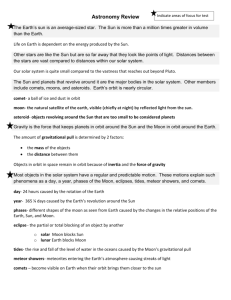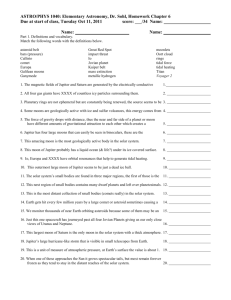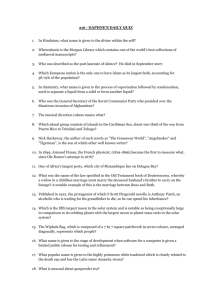“Solar System Study Guide”
advertisement
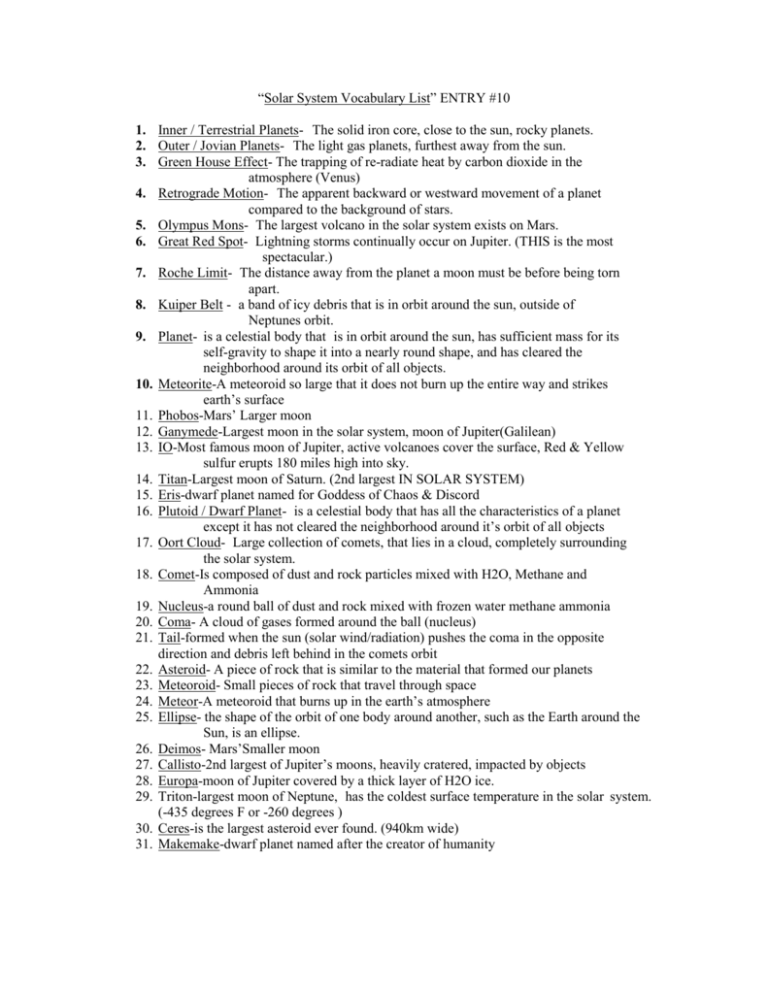
“Solar System Vocabulary List” ENTRY #10 1. Inner / Terrestrial Planets- The solid iron core, close to the sun, rocky planets. 2. Outer / Jovian Planets- The light gas planets, furthest away from the sun. 3. Green House Effect- The trapping of re-radiate heat by carbon dioxide in the atmosphere (Venus) 4. Retrograde Motion- The apparent backward or westward movement of a planet compared to the background of stars. 5. Olympus Mons- The largest volcano in the solar system exists on Mars. 6. Great Red Spot- Lightning storms continually occur on Jupiter. (THIS is the most spectacular.) 7. Roche Limit- The distance away from the planet a moon must be before being torn apart. 8. Kuiper Belt - a band of icy debris that is in orbit around the sun, outside of Neptunes orbit. 9. Planet- is a celestial body that is in orbit around the sun, has sufficient mass for its self-gravity to shape it into a nearly round shape, and has cleared the neighborhood around its orbit of all objects. 10. Meteorite-A meteoroid so large that it does not burn up the entire way and strikes earth’s surface 11. Phobos-Mars’ Larger moon 12. Ganymede-Largest moon in the solar system, moon of Jupiter(Galilean) 13. IO-Most famous moon of Jupiter, active volcanoes cover the surface, Red & Yellow sulfur erupts 180 miles high into sky. 14. Titan-Largest moon of Saturn. (2nd largest IN SOLAR SYSTEM) 15. Eris-dwarf planet named for Goddess of Chaos & Discord 16. Plutoid / Dwarf Planet- is a celestial body that has all the characteristics of a planet except it has not cleared the neighborhood around it’s orbit of all objects 17. Oort Cloud- Large collection of comets, that lies in a cloud, completely surrounding the solar system. 18. Comet-Is composed of dust and rock particles mixed with H2O, Methane and Ammonia 19. Nucleus-a round ball of dust and rock mixed with frozen water methane ammonia 20. Coma- A cloud of gases formed around the ball (nucleus) 21. Tail-formed when the sun (solar wind/radiation) pushes the coma in the opposite direction and debris left behind in the comets orbit 22. Asteroid- A piece of rock that is similar to the material that formed our planets 23. Meteoroid- Small pieces of rock that travel through space 24. Meteor-A meteoroid that burns up in the earth’s atmosphere 25. Ellipse- the shape of the orbit of one body around another, such as the Earth around the Sun, is an ellipse. 26. Deimos- Mars’Smaller moon 27. Callisto-2nd largest of Jupiter’s moons, heavily cratered, impacted by objects 28. Europa-moon of Jupiter covered by a thick layer of H2O ice. 29. Triton-largest moon of Neptune, has the coldest surface temperature in the solar system. (-435 degrees F or -260 degrees ) 30. Ceres-is the largest asteroid ever found. (940km wide) 31. Makemake-dwarf planet named after the creator of humanity “Solar System Vocabulary List” ENTRY #10 1. ___________________- The solid iron core, close to the sun, rocky planets. 2. ___________________- The light gas planets, furthest away from the sun. 3. ___________________- The trapping of re-radiate heat by carbon dioxide in the atmosphere (Venus) 4. ___________________- The apparent backward or westward movement of a planet compared to the background of stars. 5. ___________________- The largest volcano in the solar system exists on Mars. 6. ___________________- Lightning storms continually occur on Jupiter. (THIS is the most spectacular.) 7. ___________________- The distance away from the planet a moon must be before being torn apart. 8. ___________________ - a band of icy debris that is in orbit around the sun, outside of Neptunes orbit. 9. ________________- is a celestial body that is in orbit around the sun, has sufficient mass for its self-gravity to shape it into a nearly round shape, and has cleared the neighborhood around its orbit of all objects. 10. ______________-A meteoroid so large that it does not burn up the entire way and strikes earth’s surface 11. ______________-Mars’ Larger moon 12. ________________-Largest moon in the solar system, moon of Jupiter(Galilean) 13. __________-Most famous moon of Jupiter, active volcanoes cover the surface, Red & Yellow sulfur erupts 180 miles high into sky. 14. _________-Largest moon of Saturn. (2nd largest IN SOLAR SYSTEM) 15. ________-dwarf planet named for Goddess of Chaos & Discord 16. _____________________- is a celestial body that has all the characteristics of a planet except it has not cleared the neighborhood around it’s orbit of all objects 17. ____________________- Large collection of comets, that lies in a cloud, completely surrounding the solar system. 18. _______________-Is composed of dust and rock particles mixed with H2O, Methane and Ammonia 19. _____________-a round ball of dust and rock mixed with frozen water methane ammonia 20. _____________- A cloud of gases formed around the ball (nucleus) 21. _____________-formed when the sun (solar wind/radiation) pushes the coma in the opposite direction and debris left behind in the comets orbit 22. _____________- A piece of rock that is similar to the material that formed our planets 23. _____________- Small pieces of rock that travel through space 24. _____________-A meteoroid that burns up in the earth’s atmosphere 25. _____________- the shape of the orbit of one body around another, such as the Earth around the Sun, is an ellipse. 26. ____________- Mars’Smaller moon 27. _____________-2nd largest of Jupiter’s moons, heavily cratered, impacted by objects 28. _____________-moon of Jupiter covered by a thick layer of H2O ice. 29. _____________-largest moon of Neptune, has the coldest surface temperature in the solar system. (-435 degrees F or -260 degrees ) 30. ____________-is the largest asteroid ever found. (940km wide) 31. ______________-dwarf planet named after the creator of humanity 32. Haumea-



